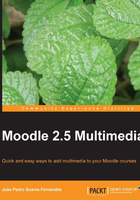
Multimedia in Moodle
Moodle was built around an idea of learning what happens when a group of people construct things for one another, collaboratively creating a small culture of shared artifacts with shared meanings (refer to http://docs.moodle.org/25/en/Philosophy).
Moodle makes available many resources (web pages, books, files, links, and so on) and activities (forums, assignments, quizzes, lessons, databases, glossaries, and so on) to support teaching and learning, but what can distinguish working with these from paper and pencil work is the way we explore the possibilities of computers and the Web to articulate multimedia elements with text. Creating these multimedia elements, a very powerful concept too, is not possible using Moodle (it is not in its scope either). So when I am talking about using multimedia in Moodle, I am talking about the creation of multimedia using other kinds of tools, later integrated, discussed, and assessed through Moodle.
Using multimedia in this way can provide more opportunities to a group of teachers and students for the construction of, in this case, multimedia artifacts . We will try to use multimedia not only as a product for better delivery, but also to improve the ways in which students can construct multimedia artifacts.
It is usually said that multimedia can be beneficial for learning, as it can approach diverse learning styles, add interactivity and learner control, reduce the time required to learn, or extend the information presented through different channels. When we talk about multimedia artifacts, we are talking about content; however, I would say that pedagogy is also important. This is why we should also value diverse classroom practices around multimedia rather than just using it exclusively for delivery.
This book was written around the design of an online course called Music for everyday life using Moodle, which is available at http://www.musicforeverydaylife.net. This course is open to everyone (no enrolment key is needed; it has a guest access), so you can share it with colleagues as it is licensed under a Creative Commons Attribution license. This gives you a lot of freedom in using and remixing the course's content in your own course.
You might ask, why music? Music, besides being fun and horizontal to all cultures, is a subject that can easily gather contributions from areas such as Science (for example, Waves and Sound), Geography (with instruments from around the world, such as the Ukulele), Languages (music in itself is a language), World History (from medieval music to jazz), or even Social Sciences (the law around creative works). This book was not made for musicians in particular, and one of its main challenges was to reach different educators from different subjects. Music is simply the way to get all of these perspectives working together.